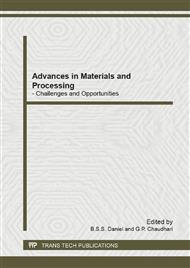p.44
p.51
p.56
p.62
p.67
p.72
p.77
p.82
p.87
Characterization of Pearlite Morphology and Associated Micro-Cracks in EN9 Grade Carbon Steel by Atomic Force Microscopy
Abstract:
Micro and Nano Features of Microstructural Properties along with Micro-Cracks and Voids, which Severely Affect the Strength and Toughness of the Material, Were Studied in Commercial EN9 Steel Round Product by Using Atomic Force Microscopy (AFM). this Has Overcome the Limitations of Optical and Scanning Microscopy. the Aim of the Present Work Is to Characterize the Pearlite Matrix Properties for Nanoscale Results as Pearlitic Morphology and Lamellae Play a Significant Role in Influencing the Mechanical Properties. it Is Also Shown that the Atomic Force Microscope Is a 3D Characterizing Tool which Can Facilitate Visualizing the Adjacent Corners in Alternate Layers of Ferrite-Cementite Lamellae. it Is Also Noted that the Micro-Sized Cracks Exist at the Weak Interfaces between the Ferrite and Cementite Lamellae, which Would Limit the Work Hardening Property of Pearlite and Thus Reduce the Ultimate Tensile Strength Significantly. in Addition, Phase Transformation from γ-Phase to Pearlite Was Schematically Predicted and Discussed as Evident from Microstructural Characterization.
Info:
Periodical:
Pages:
67-71
Citation:
Online since:
November 2012
Authors:
Keywords:
Price:
Сopyright:
© 2012 Trans Tech Publications Ltd. All Rights Reserved
Share:
Citation:


